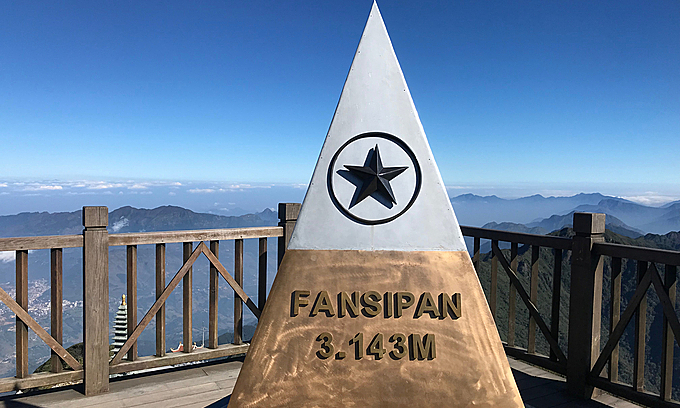
After more than 13 years, a 20-kilogram stainless steel pyramid created by a group of Hanoi travelers still stand firm on Mount Fansipan in northern Vietnam.
Meeting his “brainchild” again on the top of Mount Fansipan, dubbed “the Roof of Indochina,” in early May, Le Hong Quang could not hide his emotion and pride.
Quang said in early 2008, on the “Hearts of Vietnam” website, one of the biggest Vietnamese forums at the time, many people had shared images of a pyramid heavily damaged on the peak of Fansipan, Vietnam’s highest mountain in Sa Pa, a popular tourist town.
![[Caption]aa](https://i-english.vnecdn.net/2021/05/12/176421603-10160747964084348-53-6876-8790-1620810796.jpg)
|
|
Le Hong Quang poses for a photo on Mount Fansipan during his visit to Sa Pa in May 2021. Photo courtesy of Le Hong Quang. |
Photos of a cracked marble pyramid inspired Quang to come up with his idea of “rebirthing” the pyramid. His idea was quickly approved by Nguyen Quoc Tri, the then director of Hoang Lien Son National Park that manages the mountain.
Soon, Quang had formed a group of five members, including architect Le Thanh Van in charge of design, Nguyen Minh Tuan construction and Thanh Tung and Tan who were responsible for collecting funds.
Van designed the new pyramid that resembled the original shape built in 1964. Initially, duralumin was chosen as the material for the pyramid due to its strength and high solidity. However, it proved rare and expensive, so Tuan, a metallurgical engineer, decided to use SUS201 stainless steel instead.
He promised the new pyramid would “stay durable over time, and become shinier after experiencing wind and rain on the mount.”
On January 26, 2008 the new pyramid was completed, weighing more than 20 kilograms and 99 centimeters high. All three sides of the tip were decorated with a 5-pointed star and the words “Fansipan 3,143 meters” marked on it.
Quang took the new pyramid and headed to Sa Pa later that night.
At midnight, after reaching Yen Bai Province, the bus carrying Quang’s group broke down. In order to hand over the pyramid to Hoang Lien Son National Park’s management board on time, Quang carried the pyramid , and boarded a train to Lao Cai alone.
The next morning, the group met in Lao Cai and continued traveling to Sa Pa.
To complete their plan before Tet, Tuan and some H’mong porters piggybacked the pyramid to the top of Fansipan while Quang and other members stayed back since the journey to conquer the “Roof of Indochina” at the time was not easy at all.
It was a cold winter day, with temperatures in Hoang Lien Son sometimes dropping to below zero.
After two days of trekking, the group arrived at their destination at noon on Jan. 28. It took just half an hour to affix the metal pyramid to the mountain.
![[Caption]aa](https://i-english.vnecdn.net/2021/05/12/26952042-10156969123419348-743-4427-7626-1620810796.jpg) |
|
Quang’s group carry the new pyramid to Sa Pa, 2008. Photo courtesy of Le Hong Quang. |
After 13 years, Quang and Tuan still recall the icy coldness that crept into their bones in Hoang Lien Son forest that day. But the journey became a symbol of their pride and love for their country, a pride that fills their hearts when standing on Mount Fansipan.
Sa Pa in Lao Cai Province, about 300 kilometers (186 miles) from Hanoi, has grown in popularity for its beautiful mountains, terraced rice fields and Saturday night “love market”, a colorful exhibition of local ethnic minority culture.
Standing 3,143 meters (10,311 feet), Fansipan is a Mecca for Vietnamese trekkers.
But now, for amateur trekkers, a cable car has come to the rescue, operating from 7.30 a.m. to 4.30 p.m. every day from a station in Muong Hoa Valley. A round-trip ticket costs VND700,000 ($30) for adults and VND500,000 ($22) for children.
